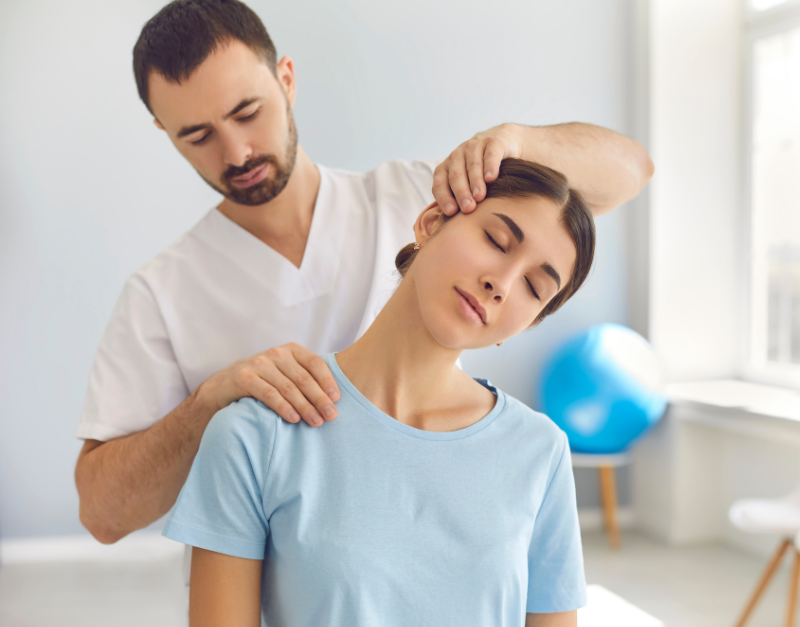
Quality Treatment With Super Affordable Price
Best Physiotherapy Treatment India
Call us anytime
Write a mail

Smartphones have become an essential part of our daily lives because they put connectivity and convenience at our fingertips in the digital age. However, a new health issue known as “text neck syndrome” has emerged due to the frequent use of mobile devices. This phenomenon describes the musculoskeletal pain and discomfort brought on by the extended use of mobile devices, such as smartphones, which can result in various neck-related problems. This article will look at the causes, signs, and treatments for text neck syndrome. Causes: The main cause of text neck syndrome is slouching while using a mobile device. We frequently hunch our necks forward and lower our heads to view the smartphone screen. The neck and upper back muscles are overworked in this posture, which hurts and is uncomfortable. When people use their mobile devices for prolonged periods while texting, browsing, or playing games, the problem worsens. Symptoms: The most typical sign of text neck syndrome is neck pain, which can be mild to severe in intensity. Unwanted side effects could occur, such as a stiff neck, sore shoulders, and upper back pain. Numbness or tingling sensations can occasionally result from pain that travels down the arms. Bad neck posture while texting can result in these issues, headaches, restricted mobility, and muscle imbalances. Preventive Measures: Keep a Good Posture: Be mindful of your posture when using a mobile device. By holding your phone at eye level, you can maintain a neutral position for your neck. Stay away from forward neck flexion and protracted slouching. Frequently Break: Try to schedule a time to disconnect from your smartphone. Plan periodic stretching sessions to aid in the relaxation and recovery of your neck and back muscles after prolonged strain. Exercise and Strengthen: Regularly work out, concentrating on strengthening your neck and upper back muscles. You can lessen your stress and maintain good posture by doing this. Ergonomic Adjustments: Making ergonomic changes to your work area and mobile devices would be best. Support your neck and back with pillows or other ergonomic devices while using your phone. Mindful Device Use: Reduce your screen time and use your smartphone with caution. To reduce the time spent texting, establish boundaries and set aside “phone-free” zones. Ergonomic Workstation: If you frequently use a computer or laptop, ensure your workstation is ergonomically configured. Adjust your chair, monitor, and keyboard to maintain proper posture and minimize neck and back strain. Neck Exercises: Regular neck exercise will improve flexibility and bolster the neck’s supporting muscles. Simple stretches and range-of-motion drills can prevent and treat text neck syndrome. Conclusion: As our reliance on smartphones increases, we must be aware of the potential health risks associated with prolonged smartphone use. Neck pain and discomfort are common symptoms of text neck syndrome, a problem caused by hunching over while using a phone. Taking precautions like practicing good posture, taking breaks, and exercising can lower the risk of text neck syndrome and enhance overall neck and back health. Achieving a balance between our digital lives and physical health is essential to avoid the negative effects of excessive smartphone use. For more details, you can connect with Gold Medal Physiotherapist expert doctors.

Physiotherapy’s Advantages In Asthma Management And Prevention Asthma World Day is observed annually on the first Tuesday in May to raise awareness of the condition and its effects on people’s lives. Millions of people around the world suffer from the chronic respiratory condition known as asthma. In addition to making breathing difficult, and causes other symptoms like wheezing and coughing. This year’s theme, “Asthma for All,” highlights how important it is for everyone to access top-notch asthma management and treatment. One of the most important ways to achieve this is through the use of physiotherapy in the treatment of asthma. Preventing Asthma To prevent asthma, the first step is to understand its causes. A family history of the condition, exposure to environmental irritants like smoke, dust, and chemicals, respiratory infections, obesity, stress, and other factors are a few of the complicated health conditions that can cause asthma. Identifying and addressing these risk factors can reduce the likelihood of developing asthma. There are several ways to avoid developing asthma, including: Physiotherapy for the Treatment of Asthma Enhancing lung function, reducing symptoms, and improving the quality of life for those with asthma are the main goals of physiotherapy in treating the condition. Physiotherapists use the following techniques to achieve these goals: Physiotherapy for Asthma Treatment: Benefits Physical therapy may help people with asthma breathe better, experience fewer side effects from exercise, and live better overall. The theme of World Asthma Day 2023, Asthma for All, emphasizes the significance of guaranteeing everyone access to effective asthma treatment. Everyone should have access to the resources and help needed to effectively manage their asthma, regardless of where they live or their socioeconomic status. By educating people, making medications and other necessary treatments accessible, involving healthcare professionals, and fostering community involvement, we can work toward a future in which asthma is a condition that does not affect anyone. Check out Gold Medal Physiotherapy; they provide the best Physiotherapy treatment in Gurgaon. These are a few physiotherapy treatments that Gold Medal Physiotherapy provides:

Shin splints are an overuse injury that happens frequently. The pulling and irritation of the bones and muscles in your lower leg bring on this injury. Shin splints are more common in runners, military personnel, osteoporotic individuals, and athletes. Resting is advised while shin splints heal because they have the potential to develop into stress fractures. What are Shin splints? Shin splints are a common problem resulting from exercise. “Shin splints” are a term used to describe pain along the inner tibial border. Shin splints frequently develop following exercise. They frequently have to do with running. After engaging in any physically demanding sports activity, shin splints can form, especially if you are starting an exercise program. Shin splints can be treated with straightforward methods. Ice, rest, and stretching are all frequently beneficial. Stopping the recurrence of shin splints will be easier by not overdoing your exercise regimen. Symptoms The most typical symptom of shin splints is pain along the border of the tibia. Additionally, it is possible a small localized swell. Shin splint pain may cause: Cause Shin splints typically result from overuse injuries to the leg’s bone and muscle tissue (periosteum). Following abrupt changes in physical activity, shin splints frequently appear. These involve frequency adjustments, like increasing the number of days you work out each week. Additionally, changes in time and effort, such as running further or uphill, can result in shin splints. Shin splints can also result from the following conditions: Runners are most likely to develop shin splints. Dancers and prospective military personnel are two different groups that frequently get the diagnosis. Diagnosis Physicians can recognize shin splints through a physical examination and knowledge of your medical background. Your lower leg, ankle, and foot will all be examined by your doctor, along with your gait. Your ankle and foot will be moved during a thorough examination, and the bone along the ankle and foot will be felt for any tenderness. Try standing on or hopping on the painful leg to rule out shin splints or a stress fracture. Your doctor will first order an X-ray to rule out the possibility of a stress fracture, even though they are not visible in roughly two-thirds of plain X-rays. In light of this, if your doctor has cause for concern, they may request an MRI or bone scan. Because they detect the injury prior to an X-ray, these tests enable your doctor to determine whether the shin splint has developed into a stress fracture. Treatment approach If you want your symptoms to disappear, you must give your muscles and bones time to heal. The most common course of action for shin splints includes a combination of the following: Take a break from sports, running, and other activities to allow your muscles and bones to heal. You should slow down and rest for a few weeks or longer. Apply a cold compress to your shins every 10 to 20 minutes, three to four times daily for a few days. Ice can help with the pain and swelling associated with shin splints. Nonsteroidal anti-inflammatory drugs (NSAIDs), available over the counter, can lessen pain and swelling. 1000–2000 IU of vitamin D3 per day may be helpful. Tell your doctor about any dietary supplements you take. Stretching and gently flexing your lower leg muscles might be helpful. When you do decide to start moving once more, start slowly. Increase your activity level gradually to reduce your risk of developing shin splints again. People with flat feet can effectively treat shin splint pain with shoe inserts (orthotics). Orthotics lessen the strain on the bones and muscles in your lower legs by supporting your arches. Physical therapy can help you regain mobility by strengthening your legs and reducing your risk of getting hurt again. Best Rated Physiotherapy in Gurgaon; they have treated almost hundreds of patients. If you want to know more about Shin Splints physiotherapy, visit the Gold Medal Physiotherapy website. FAQ Can I run if I have shin splints? Running is not recommended if you have shin splints. If you continue performing the exercise that triggered your painful shin splints, you risk developing stress fractures. It would be best to stop running temporarily or, at the very least, lessen your training load. Can shin splints lead to other medical problems? Shin splints are a very common overuse injury. With rest and ice, most shin splint patients recover without experiencing any long-term health problems. However, if shin splints are left untreated, they may develop into a tibial stress fracture. What kind of shoes are suggested to avoid shin splints? Your best bet is to wear shoes with good shock absorption. Pick running shoes with supportive foam that can withstand all three stride phases.


Quality Treatment With Super Affordable Price
Call us anytime
